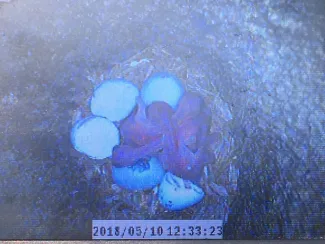Southeastern Oklahoma’s forests are often filled with birdsong in the spring, especially at the McCurtain County Wilderness Area where Oklahoma’s last remaining red-cockaded woodpeckers can be found. Clay Barnes, biologist for the Oklahoma Department of Wildlife Conservation, has been checking the woodpecker’s cavities for eggs the past month and easily picks out the woodpecker’s high-pitched squeaks from the chips, buzzes and sweet whistled notes of the area’s other birdlife.
“We’ve been seeing this family group of four birds for several weeks,” Barnes said.
The birds – a breeding pair and two “helpers” – are year-round residents of the area but have shifted their focus within the past months from surviving the winter to creating the next generation of red-cockaded woodpeckers. The breeding male’s roost cavity has since been transformed into a nursery and now holds three growing chicks.

“We started looking inside woodpecker cavities to see if their nesting season had started in late April and found two eggs in this cavity on April 27. When we checked the following Monday, that number had grown to five.” Three chicks had hatched when the cavity was later checked on May 10. At least six other woodpecker pairs are incubating eggs or raising chicks.
Red-cockaded woodpeckers typically lay 3-4 eggs a year, but Barnes has found up to six eggs inside a cavity. “It’s rare for all the eggs in a clutch that big to hatch. Some of the unhatched eggs may have been infertile, or weren’t properly incubated.”
To feed the chicks growing inside this cavity, the entire family group of woodpeckers will spend most of the day foraging for insects. They search for ants, beetles, spiders and a host of other insects by scaling the trunks and branches of the surrounding pines, flaking away chunks of bark and mining the insects hiding underneath.
The cooperative breeding strategy of the red-cockaded woodpeckers – where immature birds help the breeding pairs with incubation and chick rearing duties – is fairly unique among birds.
“Only a few species of birds in the United States rely on help from family members to raise their young. And in Oklahoma, red-cockaded woodpeckers are the only species known to nest cooperatively,” Barnes said.
Barnes will continue monitoring this group of unique woodpeckers throughout the incubation period and the nestling stage.
“The whole process – from the first egg until the chicks are able to fly from the cavity – takes about six weeks. We’ll continue checking in on the eggs and growing chicks each week to make sure the woodpeckers are safe and healthy.”